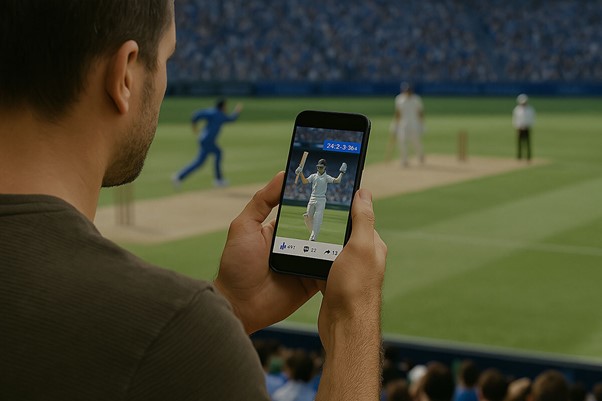Growing up in a cricket-obsessed household in the 90s, I vividly remember the ritual of Sunday afternoons – dad with his scorecard, grandpa arguing with the TV, and me trying to make sense of it all. Fast forward to 2025, and cricket consumption has transformed almost beyond recognition. Having followed this evolution as both a fan and occasionally writing for a few cricket blogs, I’ve been fascinated by how digital technology has revolutionized our relationship with the sport. Through conversations with fellow fans, players at my local club, and my own experiences jumping between various platforms during last year’s World Cup, I’ve gathered some thoughts on the innovations that are genuinely changing how we experience the game we love.
1. Enhanced Broadcast Experiences Through Augmented Reality
Remember when we thought the red tracer for the ball path was revolutionary? God, I feel old writing that. Today’s broadcasts make those early innovations look primitive. Last month during the England-Australia Test, my cricket-skeptic girlfriend actually got interested when the broadcast showed a 3D visualization of how the bowler was setting up the batsman over six deliveries – subtle variations in line, length, and seam position that I’d been trying to explain for years made instantly clear through AR overlays. The tech doesn’t just show what happened – it reveals the “why” behind it. My local club now uses similar (though obviously less fancy) analysis tools, and it’s transformed how our weekend warriors understand their own performances. I watched our captain use AR visualizations from professional matches to explain field placements to newer players – something that would’ve required hours of theoretical explanation previously. What impresses me most is how these visualization tools have democratized cricket’s technical aspects. My American colleague who never understood cricket’s appeal finally “got it” when ball-tracking showed just how much a delivery had moved in the air and off the pitch. His exact words: “That’s physically impossible!” But the tech showed him it wasn’t – creating another convert to our wonderful, complicated sport.
2. Fantasy Cricket’s Evolution into Interactive Ecosystems
Fantasy sports weren’t invented for cricket, but cricket has our sport embraced them! I was initially dismissive – “just another distraction,” I probably snobbishly declared. Then my nephew challenged me to join his league, and I’ve been hopelessly addicted ever since. You can Play Fantasy Cricket on MPL and suddenly find yourself intensely invested in a random Tuesday match between teams you normally wouldn’t care about because your captain choice is playing. What’s fascinating is how it’s changed my viewing behavior. I caught myself cheering for a bowler I usually can’t stand because he was in my fantasy XI – then feeling weirdly guilty about it! These platforms have evolved beyond simple player selection into complex ecosystems with stats, social features, and mini-games that keep you engaged throughout tournaments. My wife laughs at how our friend group chat explodes during matches now – 30% about the actual game, 70% about fantasy performances and transfers. Even my technophobe uncle has downloaded the apps and regularly calls me to debate selection strategies. Fantasy cricket hasn’t replaced traditional viewership – it’s added a complementary layer that makes almost every match personally relevant, even when your favorite team isn’t playing.
3. Social Media’s Transformation of Player-Fan Relationships
Cricket was once defined by its distance – players were these unreachable figures we knew only through carefully managed interviews and broadcasts. Social media has absolutely shattered that dynamic, sometimes for better, occasionally for worse (like when my favorite bowler posted those political views I strongly disagreed with – that was a day of reckoning!). Last rain delay during the IPL, I was mindlessly scrolling through Instagram when the very player I had been criticizing started a live session from the dressing room. Suddenly he was answering questions, showing his match preparation, bantering with teammates – completely unfiltered. His explanation of how he approaches different batting situations actually changed my mind about his technique. I’d been wrong in my criticism, something I sheepishly admitted in the comments. These platforms have revealed the humans behind the performance statistics. When a senior player posted about his struggles with anxiety between matches, it sparked a conversation at my local club that would have been unimaginable ten years ago. Young players openly discussing mental health? The digital breaking of barriers between professionals and fans has created ripple effects throughout cricket culture.
4. Mobile Applications Creating Omnipresent Cricket Ecosystems
During my cousin’s wedding last year (inconsiderately scheduled during a crucial Test match), I wasn’t the only one sneaking peeks at my phone. The uncle who once declared smartphones “the death of conversation” was beside me with his own cricket app, whispering updates during the ceremony. Cricket has become truly portable, accessible in previously impossible situations. The sophistication of these apps continues to amaze me. During a work trip to an area with terrible internet, I followed an entire T20 match through a lightweight app that used minimal data to send ball-by-ball 3D reconstructions – no video needed. I’ve customized my notifications to alert me only for specific milestones and players I follow, creating a personalized cricket news service tailored to my interests. What’s particularly impressive is how these platforms have expanded cricket’s reach. My colleague from a region without strong broadcast infrastructure follows matches exclusively through these apps. They’ve created access points where traditional media models failed. The asynchronous nature means I can engage meaningfully with a day’s play even when life gets in the way of watching live – catching key moments, analysis, and community reactions on my own schedule.
5. Data Analytics Transforming Fan Understanding
I still have my dad’s old scorebooks – meticulous records of matches with basic statistics that were once considered comprehensive analysis. The statistical revolution in cricket has been staggering. I recently overheard two teenagers at a local match discussing “expected wicket value” and “pressure index” – concepts that would have seemed like science fiction in my youth. Last season, our club introduced advanced analytics tools previously available only to professionals. The insights were sometimes humbling (turns out I’m statistically terrible against left-arm spin – something my teammates now mercilessly exploit in net sessions), but they’ve transformed how we understand our own performances. What I appreciate most is how these advanced metrics have created new ways to appreciate different types of contributions. The data revealed our unassuming middle-order batsman was actually elite at rotating strike during middle overs – a skill traditional statistics completely missed. This democratization of analytics has filtered into everyday cricket conversations, creating more nuanced discussions about player value beyond obvious metrics like runs and wickets. The visualization tools are particularly impressive – complex statistical concepts become immediately clear through intuitive graphics. My cricket-indifferent partner can now understand shifting match dynamics through win probability graphs that wouldn’t have made sense as raw numbers. These tools haven’t replaced traditional viewership – they’ve enhanced it, adding layers of understanding that enrich the emotional experience.
Conclusion
Looking back at cricket’s digital transformation over the past decade reminds me of how the sport itself has always balanced tradition and innovation. The same game that took decades to embrace limited-overs formats has now pioneered some of the most advanced fan engagement technologies in sports. What gives me hope is how these innovations haven’t replaced what makes cricket special – they’ve amplified it, making the sport more accessible, understandable, and engaging across different audiences. Technology has created multiple entry points to cricket appreciation, accommodating everything from casual interest to obsessive statistical analysis.
Image by https://www.mpl.live/fantasy-cricket




